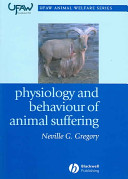Physiology and Behaviour of Animal Suffering

Suffering is a state of mind that is difficult to measure and analyse in human beings and considerably more so in animals. It is related to the environment in which we live and our physical and mental states. Understanding the physiology of suffering in animals is crucial in assessing animal welfare. Written by an expert in applied welfare aspects of physiology, this book is the first to address the physiological aspects of suffering in animals. It explores the different causes of suffering – physical discomfort, thirst and hunger – the responses in the body that lead to suffering and it offers insight into how suffering can be managed. The second book in a major new animal welfare series Draws together information that is scattered across the literature Written for the specialist and non–specialist Includes colour plate section
Autor: Neville G. Gregory
| Nakladatel | Wiley-Blackwell |
|---|---|
| ISBN | 9780632064687 |
| Vydání | 2004-11-22 |
| Vazba | brožovaná |
| Počet stran | 280 |
Foreword.
Preface.
1 Introduction.
1.1 What Is Suffering?.
1.2 Why Worry about Suffering?.
1.3 When Can We Stop Worrying about Suffering?.
1.4 Recognising Suffering in Animals.
1.5 Can Animals Go Mad?.
1.6 What Constitutes Animal Suffering?.
1.7 Conclusions.
2 Stress.
2.1 Stress Physiology.
2.2 Stress–related Disorders.
2.3 Restraint Stress.
2.4 Stress–induced Analgesia.
2.5 Stress–induced Seizures and Fits.
3 Anxiety and Fear.
3.1 Introduction.
3.2 Anxiety.
3.3 Experimental Models.
3.4 Fear. 3.5 Fright.
3.6 Phobias.
3.7 Panic.
3.8 The Role of the Amygdala.
3.9 Losing One’s Mother.
4 Emotional Numbness and Deprivation.
4.1 Anhedonia.
4.2 Depression.
4.3 Social isolation in the Newborn.
4.4 Sensory Deprivation in Early Life.
4.5 Sensory Deprivation in Later Life.
4.6 Social isolation and barren environments.
4.7 Stereotypies and neurotic behaviours.
4.8 Learned Helplessness.
4.9 Post–traumatic Stress Disorder.
4.10 Sleep Disorders.
4.11 Weaning.
4.12 Physiology of Emotions.
5 Aggression, Overcrowding and Discomfort.
5.1 Aggression.
5.2 Overcrowding and Confinement.
5.3 Discomfort.
6 Exercise.
6.1 Overexertion.
6.2 Endurance Riding.
6.3 Horse–racing Injuries.
6.4 Greyhound Racing Injuries.
6.5 Migration.
7 Cold.
7.1 Cold Discomfort and Pain.
7.2 Skin Freezing and Chilblains.
7.3 Hypothermia.
7.4 Sensitivity to Cold.
7.5 Hypothermia and Cold Survival.
7.6 Cold in Combination with Starvation.
7.7 Cold–induced Analgesia.
8 Heat and Burns.
8.1 Heat Stress.
8.2 Heat Intolerance.
8.3 Some Species Differences.
8.4 Pain.
8.5 Burns and Scalds.
9 Thirst and Hunger.
9.1 Thirst and Dehydration.
9.2 Overhydration.
9.3 Osmotic Stress.
9.4 Hunger.
9.5 Underfeeding.
9.6 Emaciation.
9.7 Inappropriate Diets.
9.8 Forced Moulting.
9.9 Force–feeding and Overeating.
10 Pain.
10.1 The Value of Pain.
10.2 Pain Associated with Trauma.
10.3 Ways in Which Animals Express Pain.
10.4 Pain Pathways and Consciousness.
10.5 Cortical Regions.
10.6 Applied Neurology of Pain.
10.7 Pain in a Given Context.
11 Trauma.
11.1 Injuries in Selected Body Regions and Tissues.
11.2 Some Common Causes of Injury.
11.3 Intended or Avoidable Causes of Trauma.
11.4 Types of Injury.
12 Sickness and Disease.
12.1 Is Suffering an Inevitable Consequence of Being Ill?.
12.2 Do the Behaviours Expressed During Sickness Serve a Purpose?.
12.3 Cytokines and Sickness Behaviours.
12.4 Cancer. 12.5 Stress and Immune Function.
12.6 Corticosteroid Therapy.
12.7 Anaemia. 12.8 Hazards of Improving Disease Control. 12.9 Diseases Used in Controlling Pests.
13 Digestive System.
13.1 Nausea.
13.2 Vomiting and Retching.
13.3 Gut Pain.
13.4 Diarrhoea.
13.5 Gut Injuries.
13.6 Stress and the Gut.
13.7 Gastro–intestinal Ulcers.
14 Poisoning.
14.1 Wartime Poisons.
14.2 Environmental Toxicants.
14.3 Vertebrate Pesticides.
15 Respiratory System.
15.1 Asphyxia.
15.2 Breathlessness.
15.3 Carbon Dioxide Inhalation.
15.4 Drowning.
15.5 Pulmonary Oedema.
15.6 Hypoxia.
15.7 Altitude Sickness.
15.8 Decompression.
15.9 Collapse of the Lung and Pneumothorax.
15.10 Asthma and Allergies.
15.11 Ammonia.
15.12 Signs of Respiratory Distress.
15.13 Agonal Gasping.
16 Dying.
16.1 Euthanasia.
16.2 Decapitation.
16.3 Religious Slaughter.
16.4 Death from Brain Injury.
16.5 Recognising Insensibility and Brain Death.
References.
Abbreviations.
Index.
http://www.wiley.com/WileyCDA/WileyTitle/productCd-0632064684.html